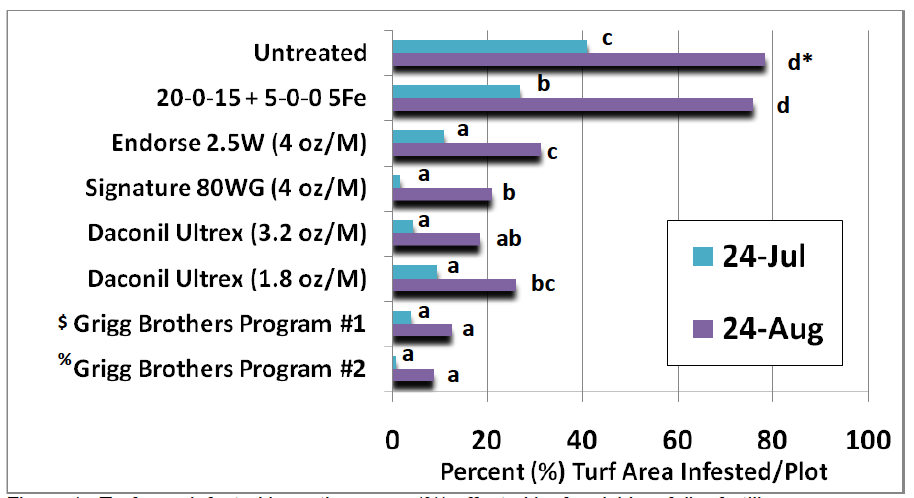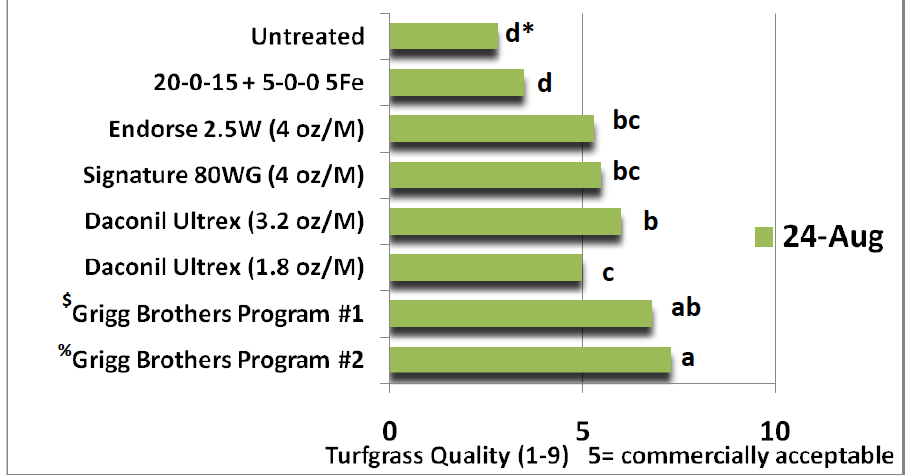Chemical and Biological Fungicides for Preventative Control of Anthracnose
Impact of Chemical and Biological Fungicides for Preventative Control of Anthracnose on an Annual Bluegrass Green (2009), B. B. Clarke, Rutgers University
Abstract
Anthracnose (Colletotrichum cereale) has become a major disease problem on annual bluegrass (Poa annua) putting greens. An integrated and preventative approach remains the most effective management strategy for lessening the severity and incidence of this disease, including the utilization of appropriate cultural practices, and a rotational fungicide program. Low mowing heights, low N or unbalanced fertility, and the onset of specific environmental factors increase the risk for anthracnose development. The objective of this trial was 1.) Determine the effect of a combined foliar fertilizer (spoon feeding nitrogen) and potassium phosphite program applied every fourteen (14) days with a lower label rate of chlorothalonil on anthracnose incidence and severity and 2.) Determine if a programmatic approach of increasing the rate of chlorothalonil during heavy disease pressure will further lessen the severity of anthracnose severity on an annual bluegrass putting green. Foliar nitrogen (N) [Gary’s Green Ultra® – 13-2-3 (0.16 lbs N)] and potassium phosphite [P-K Plus® – 3-7-18 + 14% potassium phosphite (K2PO3)] applied in combination with Daconil Ultrex® (1.8 oz/M) provided excellent anthracnose suppression on July 24 under low to moderate disease pressure which was better than Daconil Ultrex (1.8 oz/M) applied alone and significantly better than the untreated check (Figure 1). When the disease pressure became severe on August 7, the 3.2 oz./M rate of Daconil Ultrex was combined with the foliar fertilizer program and provided enhanced disease suppression on August 24 (Figure 1). On August 24, both Grigg Brothers programmatic approaches provided significantly better disease suppression than Daconil Ultrex (1.8 oz./M), Chipco Signature® 80WG (4 oz./M) and Endorse® 2.5W (4 oz./M) treatments (Figure 1). The best turf quality& was provided by the GRIGG™ programs, due in large part to the added N which limits anthracnose development and the overt color response provided by efficiently utilized nutritional inputs (Figure 2). Zero phytotoxicity was observed during the course of this study for any of these treatments. Based on these results and those from 2007 and 2008, utilize a consistent N spoon feeding approach, P-K Plus (potassium phosphite) and Daconil Ultrex (1.8 oz/M) (7-14 days) under slight to moderate disease pressure. Initiate this program prior to the onset of visual disease symptoms. When environmental conditions become most adverse and anthracnose pressure increases, increase the rate of Daconil Ultrex (3.2 oz./M) and apply with the foliar fertilizer program to further limit disease development. Rotate fungicide chemistries for added control. Considering annual chlorothalonil application restrictions and the cost of fungicides, these programs should be seriously considered and used as part of an integrated anthracnose management strategy, and to enhance turfgrass color, quality, and vigor.
Daconil Ultrex® is a registered trademark of Syngenta Professional Products, Endorse® is a registered trademark of Cleary Chemical, and Signature® is a registered trademark of Bayer Crop Science.

Figure 1. Turf area infested by anthracnose (%) effected by fungicides, foliar fertilizer program containing potassium phosphite, and combination of a foliar fertilizer and fungicides applied every 14 days.
* Means followed by the same letter, and for the same date, are not significantly different using Walker-Duncan k ratio t-test (k=100)
$ GB Program #1 consisted of Gary’s Green Ultra (15 fl. oz./M) + PK Plus (6 fl. oz./M) + Daconil Ultrex (1.8 oz./M)
% GB Program #2 consisted of above program applied until disease intensity was considered severe (Aug. 7), then 3.2 oz. of Daconil Ultrex was applied for the remainder of the study with foliar program (as listed above).

Figure 2. Turf quality as effected by fungicides, foliar fertilizer containing potassium phosphite, and combination of a foliar fertilizer and fungicides applied every 14 days.
* Means followed by the same letter are not significantly different using Walker-Duncan k ratio t-test (k=100)
$ GB Program #1 consisted of Gary’s Green Ultra (15 fl. oz./M) + PK Plus (6 fl. oz./M) + Daconil Ultrex (1.8 oz./M)
% GB Program #2 consisted of above program applied until disease intensity was considered severe (Aug. 7), then 3.2 oz. of Daconil Ultrex was applied for the remainder of the study with foliar program (as listed above).
& Turf quality measured as uniformity, color, and disease incidence